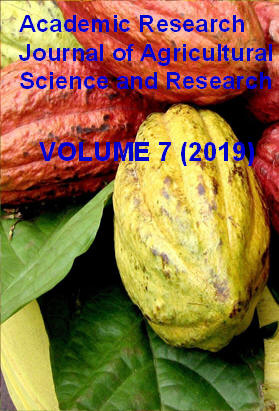|
ISSN: 2360-7874 |
Academic Research Journal of
Agricultural Science and Research |
|||||||||||||||||||
|
Vol. 7(7), pp. 493-502, November 2019 Research Resurgence of soil acidity problem and the associated available phosphorus dearth over time after lime amendment in soybean production at Bako area, Western Ethiopia
Derib Kifle
Ethiopian Institute of Agricultural Research, Holeta Agricultural Research Center, P O box 31, Ethiopia
Accepted 8 November 2019
A field experiment study was carried out at Bak Agricultural Research Center during 2012-2015 cropping seasons to investigate the duration of lime reaction in the soil and to determine the optimal level and frequency of lime applications and to identify economically viable mixes of lime and P fertilizer in improving soybean productivity and acidic properties of the soil. Factorial combinations of four lime levels (2.3, 3.45, 4.6 and 5.75 t ha-1) and four P rates (11.5, 23, 34.5 and 46 kg P2O5 ha-1) were laid out in Randomized Complete Block Design (RCBD) with three replications. The results of the study showed that the highest grain yield (4.37 tons ha-1) was recorded from the use of sub optimal (75% rec.) amount of P2O5 with slightly over optimal (125% rec.) level of lime Similarly, the interaction of lime application by cropping season was significantly different for seed yield where the maximum mean grain yield of 3.87 tons ha-1 was obtained in the second cropping season improving soybean productivity by 148% compared to the control. In the other standpoint, the soil laboratory analytical result after harvest showed that the highest soil pH (6.22) was recorded from the combination of 5.75 t lime ha-1 and 23 kg ha-1 of P2O5 Conversely, the exchangeable acidity was significantly reduced to 0.52 cmol (+) kg-1 due to application of the highest dose of lime(5.75 t lime ha-1) that improved the potential acidity level of the soil by 196%. The highest soil available P (21.99 mg kg-1 of soil) was recorded from the plots treated with 5.75 tons ha-1 of lime and 46 kg ha-1 P2O5. The soil test result showed that all tested soil parameters were affected by cropping season in which the highest record was obtained during the second cropping season after lime application which afterward witnessed a decreasing tendency during the third and fourth years after lime application indicating that the subsequent liming intervention should be made at this time to sustain the soil and soybean productivity of acidic soils across these parts of the country.
Keywords: Soil acidity, soil fertility, liming frequency, optimal combination
How to cite this article (APA Style): Derib K (2019). Resurgence of soil acidity problem and the associated available phosphorus dearth over time after lime amendment in soybean production at Bako area, Western Ethiopia. Acad. Res. J. Agri. Sci. Res. 7(7): 493-502
|
|||||||||||||||||||
